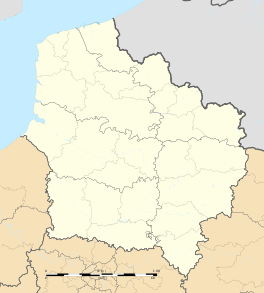Tourcoing
| Tourcoing | |||
|---|---|---|---|
|
Town hall | |||
| |||
 Tourcoing | |||
|
Location within Hauts-de-France region  Tourcoing | |||
| Coordinates: 50°43′56″N 3°06′14″E / 50.7323°N 3.1040°ECoordinates: 50°43′56″N 3°06′14″E / 50.7323°N 3.1040°E | |||
| Country | France | ||
| Region | Hauts-de-France | ||
| Department | Nord | ||
| Arrondissement | Lille | ||
| Intercommunality | Lille Métropole | ||
| Government | |||
| • Mayor (2014-2020) | Gerald Darmanin | ||
| Area1 | 15.19 km2 (5.86 sq mi) | ||
| Population (2012)2 | 92,707 | ||
| • Density | 6,100/km2 (16,000/sq mi) | ||
| Time zone | CET (UTC+1) | ||
| • Summer (DST) | CEST (UTC+2) | ||
| INSEE/Postal code | 59599 / 59200 | ||
|
1 French Land Register data, which excludes lakes, ponds, glaciers > 1 km² (0.386 sq mi or 247 acres) and river estuaries. 2 Population without double counting: residents of multiple communes (e.g., students and military personnel) only counted once. | |||
Tourcoing (French pronunciation: [tuʁ.kwɛ̃]) is a city in northern France. It is designated municipally as a commune within the département of Nord. Located to the north-northeast of Lille, adjacent to Roubaix, Tourcoing is the chef-lieu of two cantons and the fourth largest city in the French region of Hauts-de-France ranked by population with about 94,000 inhabitants.
Together with the cities of Lille, Roubaix, Villeneuve-d'Ascq and eighty-one other communes, Tourcoing is part of four-city-centred metropolitan area inhabited by around 1.1 million people: the European Metropolis of Lille.[1][2] To a greater extent, Tourcoing belongs to a vast conurbation formed with the Belgian cities of Mouscron, Kortrijk and Tournai, which gave birth to the first European Grouping of Territorial Cooperation in January 2008, Lille–Kortrijk–Tournai with an aggregate of just over 2 million inhabitants.[3]
Main sights
- Church of St Christopher (15th-16th centuries), considered one of the most beautiful Neo-Gothic edifices of Nord. In stone and brickwork, it has an 80-metre (262-foot) high bell tower with more than 80 bells.
- Hospice de Havre, founded in 1260. The cloister and the chapel date from the seventeenth century.
- Hôtel de ville (1885), in Napoleon III-style.
- Jardin botanique de Tourcoing, a botanical garden and arboretum.
History

The city was the site of a significant victory for France during the French Revolutionary Wars. Marshal Charles Pichegru and his generals Joseph Souham and Jean Moreau defeated a combined force of British and Austrian troops in the Battle of Tourcoing on 29 Floréal II (18 May 1794).[4]
Transport
The Gare de Tourcoing is a railway station offering direct connections to Lille and Paris (high speed trains), Kortrijk, Ostend, Ghent and Antwerp. The town was formerly served by the Somain-Halluin railway.
Notable people
- Yohan Cabaye, footballer currently playing for Crystal Palace.
- Jean-Marc Degraeve, chess grandmaster.
- Stéphane Denève, conductor
- Brigitte Fossey, actress
- Anna Gomis, wrestler
- Henri Padou, water polo player and 1924 Olympic gold medallist
- Brigitte Lahaie, pornstar
- Joseph-Charles Lefèbvre, bishop of Bourges, cardinal, cousin of
- Marcel Lefebvre, missionary priest and, later, controversial archbishop, cousin of Joseph-Charles
- Mr. Sam, a popular deejay and producer running his own record label since 2008.
- Albert Roussel, composer
Guilbert de Lannoy (1545-c. 1601) and his son Jean de Lannoy (1575-c. 1605) were Protestants from Tourcoing who resettled in Leiden, Holland. Jean's son, Philip Delano (c. 1603 - c. 1681-82; born Philipe de la Noye or Philipe de Lannoy), was an early emigrant to the Plymouth Colony and progenitor of the prominent Delano family, which counts among its descendants prominent figures in American history, including president Franklin Roosevelt.[5]

International relations
Twin towns – Sister cities
Tourcoing is twinned with:
See also
- Battle of Tourcoing (1794)
- Free Institution of Sacred Heart
- Communes of the Nord department
- Verlaine Message Museum
References
- ↑ Ezelin, Perrine (April 2, 2015). "European Metropole of Lille Local Action Plan" (PDF). Edinburgh, UK: CSI Europe URBACT. p. 3. Retrieved 2015-07-22.
- ↑ URBACT (May 29, 2015). "Lille". Edinburgh, UK. Retrieved 2015-07-22.
- ↑ Durand, Frédéric (May 12, 2015). "Theoretical framework of the cross border space production the case of the Eurometropolis Lille-Kortrijk-Tournai" (PDF). Luxembourg, L: EUBORDERSCAPES. p. 18. Retrieved 2015-07-22.
- ↑ Soboul, Albert (1975). The French Revolution 1787–1799. USA: Vintage. p. 404. ISBN 0-394-71220-X.
- ↑ "Pilgrim Village Families Sketch: Phillip Delano/De la Noye". American Ancestors. New England Historic Genealogical Society. Retrieved 24 August 2014.
External links
| Wikimedia Commons has media related to Tourcoing. |
- Tourcoing town council website (in French)
- Tourcoing Volley-Ball Lille Métropole (Official website of the top team, in French)
- See pictures from Antonio Mucherino's web site

.svg.png)
.svg.png)